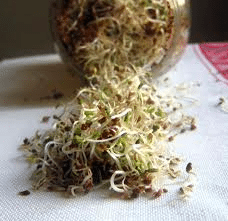Sprouting For Health can be one of the funnest cooking journeys you can take! In the kitchen there is not much better than watching a seed sprout under your care. And the best part is the tasy treats you will enjoy after the sprouting occurs.
Sprouts contain all elements a plant needs for life and growth. These same elements are in large part what your body needs to repair and rebuild those 60 trillion cells that split inside of you on a daily basis. When you sprout your seeds they germinate. Germination converts starch to simple sugar, causes fat to break down into life giving EFAs, minerals merge with protein thus increasing digestible nutrient content and proteins become predigested amino acids. Research shows that sprouts contain one of the highest rated vitamin and mineral content. www.livingonhighspeed.com
Among their other virtues sprouted seeds are low in cost, can be stored indefinitely, are easy to grow, and when sprouted increase their nutritional value many times.
Sprouts are best when eaten raw. You can eat the entire sprout, including leaves and roots. Sprouts can be eaten by themselves, be added to salads, sandwiches, soups, blended for smoothies, baby food, sauces, and dressings. They can be stored for up to two weeks if refrigerated.
Other Attributes Of Sprouting
Sprouts are a powerful source of antioxidants in the form of vitamins, minerals and enzymes which assist in protecting the body from free radical damage.
Sprouts are alkaline.
Sprouts are full of living enzymes.
Sprouts can be grown in your kitchen.
Sprouts are a good source of essential fatty acids (EFA).
Sprouts are high in fiber.
Sprouts have a massive supply of vitamins. Research suggest that the vitamin content of some seeds can increase from 100% to 2000% in several days of sprouting.
Sprouts are high in minerals. During sprouting, the minerals are enriched and chelation occurs making these minerals easier to be absorbed in your body.
Sprouts can be grown all year round to give a constant supply of food in the very freshest form possible.
Sprouts provide a good source of protein. Sprouts take less time to digest than meat, sprouts are living food – meat is lifeless, sprouts are alkaline – meat is acidic, sprouts can cut the cost of living – meat is a highly priced, sprouts have no additives – meat may have hormones and chemicals from farming practices, sprouts have zero cholesterol.
Sprouts are low in calories.
Sprouts have a low glycemic index.
Sprouts are awesome nutrient-dense foods.
How to Sprout
SEEDS
– Soak about one to two tablespoonfuls (seeds will expand about eight times the original amount) in a large glass jar. Fill the jar half-way with tepid water and cover it with something that breathes like cheese-cloth. Secure the cloth with a rubber band. Place in a dark area at about room temperature for about five hours. After five hours, drain, rinse, and let the seeds stand without water for about eight to twelve hours. Rinse again and drain well to prevent rotting. For the next six days the seeds should be rinsed and drained twice a day using lukewarm water. They should be kept at room temperature in a dark place. After the sixth day, place them in the light for one more day to increase their chlorophyll content.
GRAINS
– Preparation is the same as for seeds.
LEGUMES
– Due to their hardness, legumes and beans can require an initial soaking of about fifteen hours. They should be rinsed twice a day and given three days for adequate sprouting. Legume expansion is not so great as in the case of seeds and grains.

